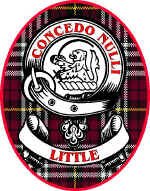
The Little Family Badge on Tartan
This modern version of the Little badge superimposed upon a tartan is used with permission of Alastair McIntyre and Electric Scotland.
Courtesy of Pj Little

The Little Family Badge
on Tartan
This modern version of the Little badge superimposed
upon a tartan is used with permission of Alastair McIntyre and Electric Scotland.
Courtesy of Pj Little
|
Settlers XXV: The Little Family--An American Odyssey | |
|
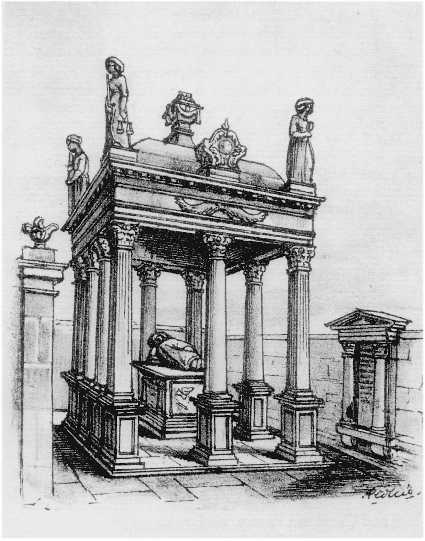
Artist's Rendering of the Little Mausoleum
Located at Greyfriars Kirkyard, Edinburgh, Scotland
About 1500-1600
Courtesy of Pj Little
THE LITTLE ODYSSEY
ummond
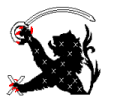
The Little Family Crest
Note: The crest of the chiefs of Clan Little was a
demi-lion in black spattered with silver saltires; in his right paw, the lion
holds a cutlass; in his left, the cross of St. Andrew. The only splash of
color is in the red claws. The crest rests on a wreath of the livery colors.
Originally attached to the top of the helmet, like the arms on the shield and
surcoat, the crest had the function of identifying the otherwise
unrecognizable fully-armored leader to his followers on the field of battle.
Our family research concerns itself with one branch of the Scottish families in America. While it is believed by some that the Litil family can be traced to the 7th Century, there is no proof, prior to their arrival in the British Isles, with the Norman conquerors in 1066, that the Little surname ever existed, and it is not known to this day how the name was actually derived.
What is known is that Litil, and its 16 variant spellings, is one of the earliest names recorded in Scottish documents. Clan Little did live in an area known as the West March and, along with more than 30 other Clan families, including the Armstrongs and Beatties, did fight for more than 400 years to wrest the control of a scrubby, hilly area known as the Scottish border from English control. Collectively, they were known as the Border Reivers, and until the Clan Chiefs were tricked into a parlay, by King James VI of Scotland, and hanged out of hand, they were thought to be one of the best light cavalry units in all of Europe. Whether the target family, or any member thereof, ever left Scotland prior to John Little's emigration to North America is unproven.
John Little was born about 1675 in Scotland, married 28 Nov 1700 in Torthorwald, Dumfriesshire, Scotland to Isabella Mhor (Gaelic spelling), and arrived in North America in the early 1700's with his wife and young sons Thomas and John. It is unclear, at least to this author, as to what became of Isabella Mhor Little. It is thought that she returned to Scotland to conduct family business on behalf of her husband and died in her homeland, but this is purely conjecture.
The Littles settled in Tinton Falls in Shrewsbury Township, Monmouth County, New Jersey and commenced to raise their family.
Shrewsbury was formed around 1667, and at that time, it encompassed a very large part of what today we call New Jersey. At that time, Shrewsbury included most of today's Monmouth County, which was formed in 1683, and all of today's Ocean County, which was formed in 1850, and some of today's Burlington County which was formed in 1694., per George Joynson, historian and genealogist, 2001.John Little purchased in 1720 a small plantation adjoining Tinton Manor owned by his friend Benjamin Morris and began to improve it. Governor Burnet appointed John Little as Judge of the Monmouth County Court of Common Pleas and Quarter Sessions, a royal appointment he held continuously from 1724 until his death in 1751. From 1738 to 1751, he was the Presiding Judge. (See Court Minutes 1724-1751, Book 2, County Court House Freehold, N.J. and Court Records 1738-1751; N.J.A. 1st. Ser.Vol. XVI p.90) This court, composed of five judges, had both judicial and administrative powers and functioned as a law court as well as the equivalent of the modern day County Commissioners. They were the only government the citizens ever came in contact with.
Although he was a man of influence, who was educated and had prior military experience, and intensely proud of his Scottish heritage, and despite his considerable possessions and honors, John Little was above all a fierce and uncompromising friend of the liberties and privileges "of the people." For more than a quarter of a century he was a powerful member of the small group of judges and country squires who were literally the autocratic dictators of the civil, military and economic life of Monmouth County. During this time, he lived in a privileged world with friends and family. It was to this life his sons were raised and educated.
These gentlemen farmers of New Jersey then enjoyed a plentiful existence from the fruits of their labor. The slave-operated plantations were self-supporting in that they wove cloth from the wool of their sheep, made their own implements, and candles, grew their own fruits and vegetables and raised livestock. The grains from their fields were ground at their grist mill and sold to markets in New York and Pittsburg as were the other products from the farms. Additionally there was an abundance of wild game, deer, fowl, and harvest from the nearby waters. This utopian existence lasted until the Revolutionary War for these founding families.
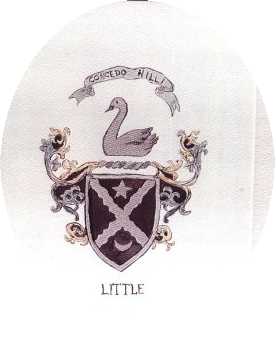
The Coat of Arms of the Little Family or Clan
of Dumfrieshire
***Used by John Little[2]
Son of John Little the
Emigrant***
Courtesy of P. J.
Little
The reproduction of the Coat of Arms was created for
the Donald C. Little book, The Little Family of
Monmouth County, New Jersey, 1951, by Louise
Little of Montoursville, PA.
It was during these plentiful years that his sons matured and John Little established the first Presbyterian Church in Shrewsbury and a second church in Sharks River. He was elected as Elder and lived to see the first church chartered by the Governor before he died.
It should now be explained that every generation in this Little family since 1700 has men named John and Thomas, and, until the use of middle names and initials became popular at the end of the 1700's, there was no easy way for outsiders to differentiate between these same named men. Therefore, a numbering system was devised to denote the first five men named John Little. Our progenitor, John Little, is numbered thusly: John Little[1].
Thomas Little wed Mary Brown and died young (ca 1731)leaving a widow and one child. Isabell Little married Andrew McDowell and had four children: Thomas (born 1750), Isabell (born 1754), Andrew, Jr. (born 1757), and George McDowell (born 1760). This information is per Scott McDowell, the seventh great-grandson of Andrew and Isabell. You can learn more about this family and their genelaogy at The Ancestors and Family of Andrew McDowell.
John Little[2] married Moica Longstreet, the daughter of Theophilus Langstraat and Moyka Laen, and to them seven children, four girls and three boys, were born. They were: Isabel, Mary, Thomas, Theophilus, Hannah, Anne and John Little[3].
Isabel married David Knott and the had twelve children. One daughter Mary wed the John Garrison Holmes we later find in Sullivan County. Both Mary and John are buried in Eaglesmere, PA. Isabel's sister Mary Little, wed Daniel Seabrook, Jr., and they had issue. When Daniel was killed during the war, Mary and her two youngest children lived with her brother Theophilus and his family. Thomas married Lydia Drummond and they had issue. Theophilus Little wed Maria Polhemus, the daughter of Daniel Polhemus and Margaretje Albertse Covenhoven, and they had six sons before migrating to Pennsylvania. Hannah first married Benjamin Dennis and had two children before he was killed in the war by the Tory Pine Tree Robbers. She then married John Lambert, who became the acting Governor of New Jersey, and they had issue. Anne Little married John Connelly and they had one daughter. John Little[3] wed Mary Leeds, and they had issue before he was killed in the war.
The will of Judge John Little[2] dated September 30, 1779 states in part: "I bequeath unto my grandson, son of my son John deceased, five hundred pounds money aforesaid if he lives to be the age of twenty-one or Chestnut Plain and thirty acres of Simon Swamp." Note: He also received the family watch that appears in the inventory of the estate of John Little[1] which was then valued at six pounds. The works of the watch are marked as 'Anto Busch of Maintz' and it is numbered 257. This bequest was for John Leeds Little.
Prior to his death, John Leeds Little, grandson of John Little[2], lived on the Chestnut Plain farm of 211 acres owned by his father, John Little[3]. It appears that he was also in charge of one of the family saw mills, possibly the one near Wreck Pond (Book L of Deeds, p.418 and Book M of Deeds, p.217). Thus, John Leeds Little became known as "Chestnut Plains John" because he inherited this farm (now located in Wayside, N.J.) from his grandfather. The 'nickname' serves to distinguish John Leeds from his cousin John Little[4], son of Theophilus and Maria Polhemus Little, and his cousin John T. Little, son of Thomas and Lydia Drummond Little.
John Little[1] died intestate 18-Mar-1751. In his Will he leaves 200 Pounds to the church, and specified items to his wife Hannah Wooley Allen (whom he married in 1732), but the bulk of the estate is left to his only heir and son John Little[2]. (Calendar of N.J. Wills, VIII, 1751-1761). The inventory of the estate was performed by Messrs. Joseph Allen and Joseph Potter.
During the time his children were born at Tinton Falls, John Little[2] was appointed to the same Monmouth County Court of Common Pleas and Quarterly Sessions as his father and had purchased a small plantation. With the death of his father and inheritance of those lands and slaves, Judge John Little[2] became known as the "rich Little."
By 1776 the plantation was well organized. Thomas, then unmarried, lived at home and assisted his father. Theophilus operated a separate part of the plantation and was part owner and manager of the mills. John Little[3] lived on yet another part of the plantation in the southern part of the county. They lived the good life content with the very best the Colonies could provide.
In a few short months all of this changed dramatically. General George Washington was defeated at the battles of Long Island and Harlem Heights. In October and November of 1776, the British, Hessians and Tories swept across New Jersey and overran Monmouth County.
John and his fellow rebels were the special object of British hatred and reprisal as they raided, plundered and laid waste to plantations and sometimes to whole sections of the county with as many as seven or eight hundred men. Thereafter the lives and property of "rebel committeeman" John Little and his children were in constant peril and remained as such for six long years.
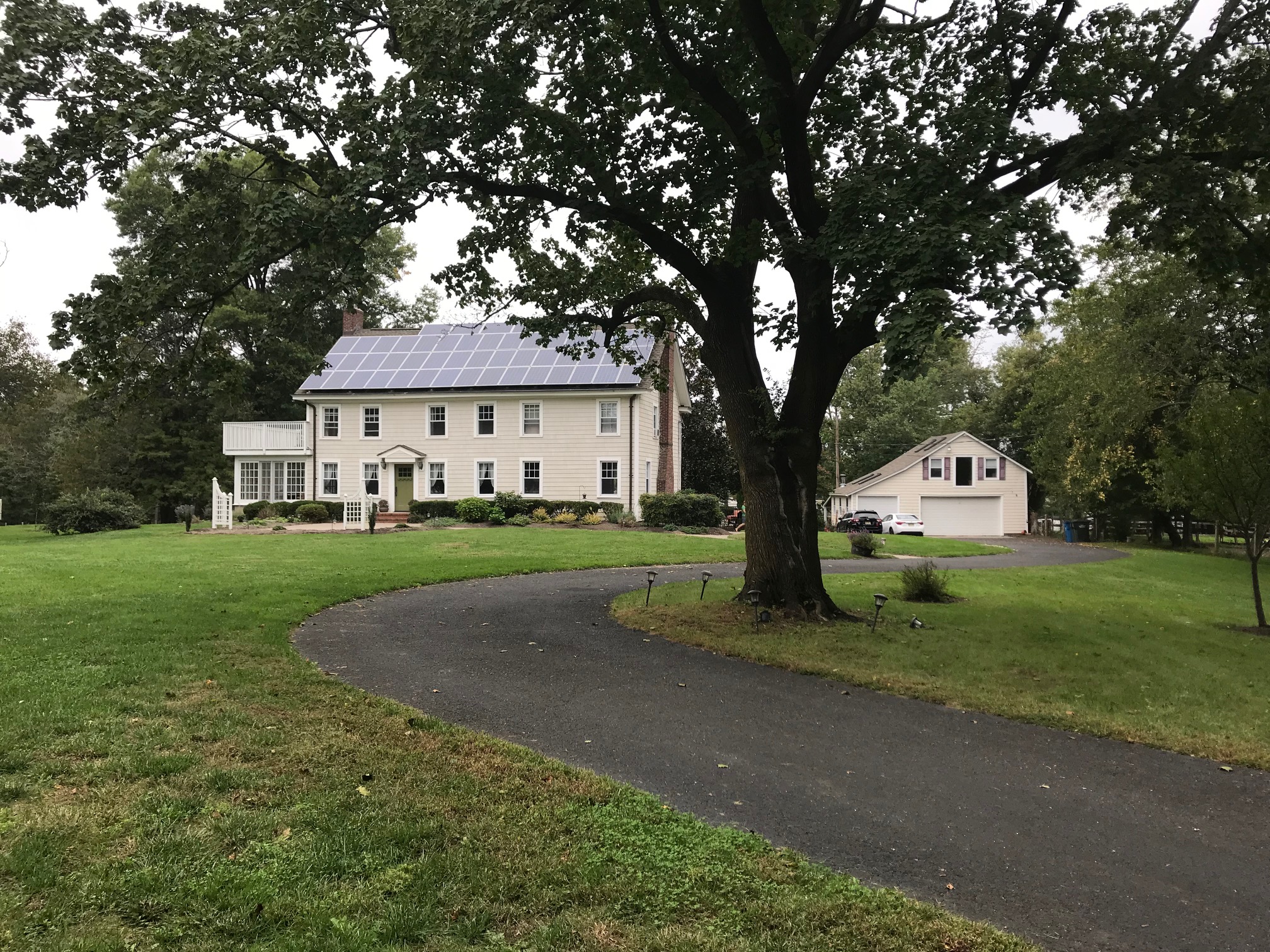
Current House on Site of Home of John Little (2)
Original Home Burned by the British in 1776
August 2019
Courtesy of Ronne Battita, The Home Owner
Pursuant to an act passed in August 1775 by the Provincial Congress providing for the immediate election of a new committee of freeholders in each township to supervise and direct the necessary business of the township and to carry into execution the resolutions and orders of the Continental and Provincial Congress, advertisements were posted for such elections.
On 22 Sep 1775, a permanent Committee of Correspondence was chosen by the Shrewsbury Freeholders, viz: Josiah Holmes, John Little[2], Cornelius Lane, David Knott, John Polhemus, Henry Green, Gavine Drummond, James Davis, Joseph Throckmorton, and Jerry Bonham.
All able bodied men between the ages of 16-50 were enrolled in the Shrewsbury Regt. of Militia under Col. Samuel Breese. This later became the 1st. Monmouth. John's son-in-law, Benjamin Dennis, was Capt. of a troop of rebel horse; Thomas Little was 2nd Lt. Grenadier Co; Theophilus was 1st. Lt. in Capt. Joseph Stillwell's Co, 1st Regiment Monmouth Militia; John Little [3] was in the same regiment with his older brother Theophilus.
The Presbyterian Church of which John Little was ruling Elder lent $600 English to the Continental Congress. From the beginning, John Little was an active member of the Shrewsbury Revolutionary Committee that directed the war of independence in the sea coast area from Sandy Hook to Barnegat Bay.
"In Monmouth County the Presbyterians formed the hard cord of rebellion against the British. The British officials in America constantly complained that the uprising against the English was "a Presbyterian plot"." (Twin Rivers by Wildes, p.59)
Because of his activities as a rebel committeeman, John Little was a marked man. His slaves, livestock and wagons were requisitioned by the British; his plantation laid to waste 26 Apr 1779; the home of daughter Hannah Dennis was entered by Hessians who knocked her down with their muskets and left her for dead. These activities took place between John Little's 64th and 72nd years. (Raun Hist. NJ, Vol 1; Barber's Hist. NJ, p. 352) His sons suffered a similar fate.
John Little[3]was killed by Hessions in 1777, leaving a wife Mary Leeds Little, (the daughter of Robert Leeds, oldest son of Japhet Leeds of Little Egg Harbor, Gloucester County, New Jersey. Japhet was the son of Daniel Leeds of Burlington County, NJ, a proprietor and a member of the Royal Council of New Jersey before his death in 1720) and only child, John Leeds Little, later known as "Chestnut Plains John".
Lieutenant Thomas Little was captured in 1777, confined in irons on a war vessel and later moved to the prison ship "Jersey". He was a prisoner of war on parole until 1781 when he was freed as part of a prisoner exchange. Thomas married Lydia Drummond and had five children. He later served in the NJ State Legislature and became the acting Lieutenant Governor of New Jersey.
Theophilus served in 1775 as a Lieutenant in Col. Sam Breese' Co. of the Shrewsbury Township Militia; 1776: Commissioned Lieutenant, 1st Reg, Monmouth County Militia; 1776: Served in Nathaniel Heard's Brigade of "Minute Men", Continental Army, and took part in the battles of Long Island and Harlem Heights; 1776: Served in Capt. Joseph lStilwell Company, 1st. Reg., Monmouth Militia; 1777: Promoted to Captain on 27th of September; 1778: Captured May 27; transfered to Sugar House, NYC in June; 1778: Released Aug 11 at New Entrecht, Long Island; 1779: Captain in Col. Asher Holmes' Regiment, Monmouth County Militia. Theophilus was a prisioner during the Battle of Monmouth. (D.A.R. records and NJ Archives)
Hannah's husband, Maj. Benjamin Dennis, was killed in 1779. Her sister Mary's husband, Lt. Daniel Seabrook, Jr., was killed during a confrontation in North Carolina. Their sister Anne's husband, Col. John Connelly, was wounded. The Presbyterian Church was partially destroyed by the British and its Pastor, Rev. Charles McKnight, was taken prisoner "for his sentiments too loudly expressed."
"This [Monmouth] County was more afflicted by these parties than all the rest of the state combined"
(Historical Collections of NJ, Barber, 1845, pages 370-371). The Revolutionary War was for all practical purposes a preview of our Civil War (fought nearly 100 years later) in that it
pitted neighbor against neighbor, friend against friend, and split families asunder. It was a long and brutal war that
caused every type of injustice known to be heaped upon the innocents. Among those guilty of the most heinous of crimes
in the annals of New Jersey history was a group known as the Tory Pine Tree Robbers. These men operated from the
bogs and pine forests of the New Jersey coast and sallied forth at night to raid, plunder and terrorize its inhabitants.
In October of 1778 they paid a visit to the home of Hanna Little Dennis, daughter of John Little[2], in search of her
husband, Capt. Dennis Little, on the pretext of reclaiming bounty captured by Dennis from a British vessel. This then
is an abbreviated account of these events as given by their daughter (then 14 years. of age), Mrs. Amelia Dennis Coryell,
in 1843. (New Jersey Historical Collection, pp.352,353, cf. Barber, 1845)
"So incensed were the inhabitants that they disinterred Fagan's remains and enveloped it in tar cloth and chains.
The body hung from a chestnut tree on Colt's Neck near Monmouth Court House. Finally the birds picked the flesh from
the skeleton and the bones fell to the ground." (New Jersey Archives, Second Series, Vol. II, p.466)
Capt. Dennis continued to pursue the Robbers, particularly Steven Emmons/Burke, whom he found with Stephen West and
Ezekiel Williams and killed as well. Others brought up were doomed to be hanged in chains like Fagan. Dennis was
promoted to the rank of Major by Governor Livingston and assigned the task of exterminating the remaining Robbers.
In July of 1779, Major Benjamin Dennis was shot and killed by Pine Tree Robbers Lewis Fenton and Thomas Emmons/Burke
while traveling between his plantation at Coryell Falls and Shrewsbury.
Hanna later married John Lambert, Esq., a member of the Provincial Congress of New Jersey. This John Lambert was the
acting Governor of New Jersey (1802-3); was elected to the Ninth and Tenth Congresses (1805-1809); and elected to the US
Senate (1809 to 1815) before he died in 1823 (Biographical Directory of the American Congress: 1774-1927, p.1119).
Hanna Little Dennis died twelve years later.
Finally these aggravated abuses aroused the passions (of its citizens) to a nearly super-human degree and little by little they succeeded in retaking New Jersey. In the process, they inspired the other colonies to increase their efforts. In 1783 the war ended with independence won.
The post-war years began with reclaiming the land and rebuilding homes, for, regardless of political sentiment, families still needed food and a place to live. The Littles had grist and saw mills, but they were, first and foremost, farmers. It was here that Thomas remained and sold products from the plantation until he moved to Pennsylvania with his parents. The second order of business was the much more daunting task of reuniting families. This was a very brutal war that was fueled in large part by loyalies to the crown. These same fierce loyalties divided families and churches, and it was years before many of their differences were settled.
John Little[2] dedicated the remaining two years of his life to reclaiming his plantation and restoring the first Presbyterian Church in Shrewsbury that his father built and saw chartered before he died in 1751. He circulated subscriptions which generated the necessary income to rebuild the church and support a minister. The names on the subscriptions are very familiar to Littles as many are related through marriage, including: Knott, Drummond, Longstreet, Polhemus, Vanderveer, Lefferts, Lane, and many others. (These documents were in possession of Donald C. Little in 1951)
In 1785, Thomas succeed his father as Elder in the Presbyterian churches in Shrewsbury and Shark River, New Jersey. Because their church had been badly damaged in the War, as previously noted, the Presbyters were invited to hold services in the Christ's Episcopal Church at Shrewsbury (G. H. Nevus, History, 1st Presbyterian Church, Shrewsbury, New Jersey, p. 5).One of the consequences of the Revolution was a kindlier feeling which was engendered between the patriots of Christ's Church and their neighbors of the Presbyterian meeting house. The Holmes, the Denis, and the Russels of the one found in the Littles, the Drummonds, the Breese and others of the Presbyterian Church, men like themselves, imbued with the spirit of liberty. Thomas Little, a ruling Elder in the Presbyterian Church, was for several years a member of the vestry of Christ's Church, Shrewsbury. (James Steen, History of Christ's Church, Shrewsbury, p. 75; History-- Old Tennant Church, Symmes, 1904 Edition. Note:Old-Tennant Church is the original Presbyterian Church in Shrewsbury)
Thomas Little and his brother, Theophilus, were appointed to the same Court of Common Pleas and Quarterly Sessions where their father and grandfather had served for 60-years. When Thomas was elected to the New Jersey Legislature, "Squire" Thomas, the son of Theophilus, was appointed to fill the vacancy. This took place in 1803. Thomas served the court for ten years during which time his uncle Thomas was chosen as the acting Lieutenant Governor. It was before this, at the turn of the century, that the family began to splinter.
In 1799, Theophilus traveled with friend George Lewis to Lycoming County, Pennsylvania where they co-jointly purchased 9,500 acres from Joseph Priestly and his wife.
Theophilus was an early pioneer and instrumental in the development of the county. Shrewsbury Township was established by a decree of the Court of Lycoming in 1803 and at that time embraced the whole of what is now Sullivan County. It is said that Theophilus Little gave it the name of Shrewsbury, that being the name of the Township where the Little family came from in Monmouth County, New Jersey (Streby's History of Sullivan County, 1903; History of Lycoming County by Meginnes, 1892, p. 567)
On July 2, 1804, Priestly and his wife Elizabeth deeded to Theophilus All of the tracts of the land situate lying and being in Lycoming Cunty on the waters of Loyasock and Muncy Creeks containing 4,500 acres wtih allowances for highways, xxx containing tracts No. 8, called Copeland, No. 9 called Hempfield, No. 10 called Belfast, No. 11 called Wilmington, No.12 called Springfield, No.13 called Woodbridge, No. 14 called Rangers Lodge, S1/2 of 15, No. 16 called Hope, No. 17 called Dovers, N1/2 of 25 called Milford, and No. 28 called Union. (Deeds, Book 5, pages 211, 212, 213, Lycoming County Court House)
On the same day, Theophilus deeded to his nephew Peter Knott 1051 acres adjoining his purchase for $1576 (Book 7, page 7), as well as 600 acres to John Garrison Holmes near the Little purchase (Book 6, page 128). Holmes moved to this area before 1810 with his family. Theophilus then returned to New Jersey where he remained actively engaged in the operation of his farms until 1813.
On 25 Jan 1811, Theophilus' son Thomas purcahsed 160 acres on Muncy Creek from John Lochard for $195 (Book 9, page 316). In November of the same year, Theophilus purchased an additional 402.5 acres from Priestly (Book 12, page 122). His sons Daniel and Tobias Little came with their families in 1804 and commenced to improve the land. A settlement called "Little's Corners" was established about a mile west of Eaglesmere and Lewis Lake at a point where the State Highway from Eaglesmere now joins the highway from Forksville to Muncy Valley.
Thomas Little with his father cleared the lands at Little's Corners a mile from the lake. Thomas afterwards exchanged lands with Tobias and went to the valley in Loyalsock. Tobias Little made a large clearing a mile or so beyond Little's Corners but built no house.
Theophilus, Jr., and his family settled in 1812 on the 402.5 acres purchased by his father on Loyalsock Creek. 1813 was a busy year for the Little family. In the spring, Theophilus, Sr. and a now seriously ill Mary, along with son Thomas with his family, arrived in Shrewsbury. Somewhat later John Little purchased 400 acres at Muncy Valley Creek and began to improve on it. On 23 November 1813, Mary died and is buried at Eaglemere Cemetery. Theophilus retained considerable acreage in Monmouth County, New Jersey, which wasn't sold until after his death in 1825. He is buried in Eaglesmere beside his wife. A picture of their grave marker is shown below. John[4] and Daniel were the estate administrators (Letters issued 30 Aug 1825 according to records at Lycoming County Courthouse, Williamsport, PA).

Grave Marker for Theophilus Little and Mary Polhemus Little
Eaglesmere, PA
Courtesy of Mrs. Fred Little
It was previously thought that Theophilus Little, George Lewis and Joseph Priestly, who previously purchased 300,000 acres, originally intended to found a settlement on Lewis Lake (now known as Eaglesmere) which would be the county seat. Theophilus deeded to his brother-in-law, State Senator John Connelly of PA, Director of the Second Bank of The United States, 900 acres on 17 Aug 1814 for $1478 (Deeds, Book 11, page 283)
So we see that, before the War of 1812, the Little family owned over 5000 acres in Shrewsbury Township, although the majority of the family still lived in New Jersey. Page 18 of the History of Sullivan County, Pennsylvania by Thomas Ingham (1899).
By the time these events had passed, "Squire" Thomas had married Lydia Jackson, the daughter of Benjamin Jackson and Rebecca Green, and later migrated to Licking County, Ohio, arriving in the winter of 1815 with their son Theophilus, daughter Jane, and son-in-law Jarod Bancroft. Daniel and Tobias were the only sons who remained on the family purchase after Theophilus, Sr. died. All of their sons, except Thomas, are buried in Eaglesmere Cemetery.
As mentioned earlier Theophilus wed Maria Polhemus, a descendent of Johannes Polhemius. They were married 26 Jan 1769 in the Dutch Reformed Church at Freehold, New Jersey. Their sons were: John Little[4], Tobias, Theophilus, Jr., Daniel, and Thomas Little, later called "Squire". Benjamin died in 1781 on the day he was born. It was this Theophilus, Sr, and his five sons, who carved Shrewsbury Township out of the Pennsylvania wilderness.
The Reverend Johannes Theodorus Polhemius was born circa 1598 near Westphalia, Germany and prepared himself for the ministry in the Reformed Church with studies in the colleges of Rhineland, Holland and Switzerland. For a time he preached in Palatine. Note: During the Thirty Years War (1618-1648) many Palatine and Westphalia families fled from Germany to the Dutch republic.Mepal in Drenthe was a large Westphalian refugee colony consisting mostly of Palatine families. Their Low-German or Saxon tongue was somewhat different than standard Dutch but very similar to the provincial dialect spoken at Meppel and in the whole of Drenthe. Desiring a minister capable of preaching in their native language , they secured the services of Rev. Polhemius from 1628 to 1630. From there he ministered in Witten, Westphalia near the town of Beckum where he remained five years. On December 3,1635 he offered his services to the Classis of Amsterdam, which held ecclesiatic authority in the territories of the West India Company, with the expressed desire to serve in America. The first ships to Brasil (Brazil) left the harbor in October of 1636. For the next seventeen years, he uninterruptedly served the Dutch Reformed Church in Brasil, first at Olinda, and then on the Island of Itamarca. It is there that he met and married his wife Catharina Vander Werven. Most if not all of his eight children were born in Dutch Brasil (now Brazil). The children were: Theodorus, Lammetje, Anna, Daniel, Margaretha, Adriana, Elisabeth and Catherina.
When he arrived on the St. Charles at New Amsterdam on Long Island, the Rev. Johannes Theodorus Polhemus found the young congregants were in need of a minister. He was duly called to minister the churches of Midwout and New Amsfort, and his family soon joined him in America. He served the churches in Long Island and Brooklyn until his death in 1676.
Notes: On February 9, 1929 the Reformed Dutch Church of Flatlands in Brooklyn celebrated the 275th Anniversary of the founding of the church by Rev. Polhemius. He was its first pastor from 1654 to 1676. (Source: The Polhemius Family, Steve Wurster, descendant)
In 1818, after setting up his own kiln, "Squire" Little built an 11-room house. All rooms except two were twenty feet square. It was the first brick home built in Licking County, Ohio and in 1951 was still a showplace in the town of Granville. Thomas, his wife Lydia, and children Jane Little Bancroft and Theophilus, were among the original settlers of this Ohio region and eventually became active in the underground railroad, since it ended in Granville. Thomas and Theophilus raised prize thoroughbred horses. A training accident left Theophilus with a permanent leg injury and unable to serve in the war. Thomas, Theophilus, and two grandsons voted for Abraham Lincoln for President in 1860. In his epitaph, a writer for the local newspaper commented that Thomas Little was the only man he ever met that witnessed the Inaugration of George Washington, the first President of the United States.
We need to make clear that at this time in our history, there were two Theophilus Littles and two Theophilus Little, Jrs.. Let us now define them.
Our first Theophilus, Sr., is the grandson of Theophilus Langstreet, and the husband of Maria Polhemus. He died in 1825 and is buried in Eaglesmere Cemetery with his wife. The first Theophilus Jr., is his son who wed Elizabeth Holmes, the daughter of John Garrison Holmes. These Shrewsbury residents are the grandparents of Sullivan County artist John Wesley Little.
The second Theophilus, Sr., is the son of "Squire" Thomas Little, and the grandson of our first Theophilus, who came to Ohio in 1816 with his sister and parents. He wed Eunice Weeks, daughter of Joseph Holland Weeks and Mary Griffiths, and they had ten children. His son, our second Theophilus, Jr., married Sarah Elliott Taylor, the daughter of General Johnathon Taylor and Sarah Elliott. (Sarah's grandfather, Samuel Elliott, built the first log cabin in Newark, Ohio in 1802.) Theophilus and Sarah were the parents of three: Clifford Talor Little who died young, U.S. Senator Edward Campbell Little, and William T. Little who participated in the Oklahoma Land Rush. (further information about these descendents can be found in links elsewhere on this site.)
Benjamin Little, the nephew of Thomas Little and Lydia Jackson, wed Sarah Wisner. the daughter of Benoni Weisner and Agnes Hooper (another prominent Lycoming family) in 1815 and they had five children. Anna, Samuel, John, and Tobias Polhemus Little were born in Lycoming County by 1824. Charlotte was born in 1832 in Ohio. The family settled in Hanover Township, Licking County, Ohio, where Tobias built many of the original houses. He and his brother John migrated to Illinois about 1850 and raised their families there.
This was not the first Little-Wisner union. John, the oldest brother, married Sarah's sister-in-law, Margaret Little, and they had four children before she died. Their sister, Agnes Nancy Wisner, married Benjamin Holmes, the son of John Garrison Holmes. This Benjamin Holmes was also a cousin of Benjamin and Margaret Little through marriage. His grandmother, Isabel Little, and Theophilus Little, the grandfather of Margaret and Benjamin Little, were the children of John Little[2]. Benjamin and Agnes Nancy Holmes had seven children.
Benoni Weisner and Agnes Hooper had eleven children. A surname spelling change was first seen in 1788 with the birth of their son John Wisner. Other children born to Benoni and Agnes were: Jane, David, Samuel, Thomas, Elizabeth, Benjamin, Margaret, William and Aaron Wisner. No other name changes are noted in this family.
Benoni was found in the first US Census in 1790 in Northumberland, Lycoming County, with a wife and two children, but was missing in the 1800 census. However he was found again in Lycoming County in the census of 1810 with his wife and several children. In the next US Census, John and David Wisner were listed as neighbors of their father. Also found in that same census of 1820 is their sister Sarah and her husband Benjamin Jackson Little. Benoni died about 1828. His wife Agnes was counted in the 1830 census but she died shortly thereafter. It was more than five years before the estate was settled and recorded at the Lycoming County courthouse.
We know that at least two generations of Wisner children were born in Lycoming County. The first generation of 11 births began as early as 1788, with the birth of Benoni's son John, and ended with the birth of Aaron in 1810. The second generation of 53 children began with the birth of John's son, Thomas Little Wisner, in 1815 and ended in 1834 with the birth of Aaron's son John Wisner. It wasn't until after the parents died that this family began to splinter and migrate westward to Ohio and Indiana. By the end of the 19th century there were nearly 200 known descendents of this family. (More about these descendents can be found in a link at the end of this page.)
It would be unfair to not mention all of the children of Theophilus and Mary as they too raised families in Sullivan County. Let us begin with the eldest son John Little[4].
John Little first married Ann Jackson, and they had five children. Benjamin, Margaret, Mary, John Coryel Little, and Elizabeth "Betsy" Little. After Ann died, he returned to New Jersey and in 1804 married Mercy Dennis in Hunterdon County. They had eight children: Dennis, Samuel, Thomas Dennis Little, Mariam, Hannah, Lydia Ann, Mercy and Amelia. Thomas Dennis Little migrated to Illinois in 1845.
Daniel, the second son, married Nellie Conover and they had eight children. They were: Daniel Seabrook, who married Benjamin's sister Elizabeth "Betsy" Little; Eleanor; John; Ann; Mary; Lydia; Peter; and William Polhemus Little.
The third son is "Squire" Thomas who married Lydia Jackson and had two children: Jane Little, who married Jarod P. Bancroft, and Theophilus Little.
Theophilus, Jr., the fourth son, wed Elizabeth Holmes and they had nine children. Their names are: Mariah, David Knott Little, Benjamin who married Faith Grange, Ann, Clementine, John Polhemus Little, Josiah, Louisa, and Daniel Little who married Anna Cales.
The fifth, and last living son born to Theophilus and Mary was Tobias Little. He married Content Allen and had the following children: Nathan Allen Little, Theophilus (died young), Henry, Thomas who wed Mary Bennett, Daniel "Red Dan" Little, John Lambert Little and Joseph Bloomfield Little.
As we have seen, the Little Odyssey has taken us from the West March of Scotland to the shores of New Jersey in 1700 A.D., to the mountains of Eastern Pennsylvania in 1800 A.D., through the Ohio Valley and the fertile farmland of Illinois, into the Plains states of Kansas and Oklahoma and the 20th Century. Today there are 45,000 Little families in English speaking countries. The descendents of John Little can still be found in Monmouth County, New Jersey; Sullivan County, Pennsylvania, Licking County, Ohio, Fulton and Champaign Counties in Illinois. Their pioneering ancestors settled, farmed the land, raised children and supported their communities just as they continue to do 300 years later.
The following links provide additional information on various Little individuals and families and on the Revolutionary War and the
environment in which the Little families helped to build the United State:
Links to the Little Family and their descendants::
1-John Little[1] group chartSullivan County families related to the Little family through marriage:
1-Holmes Family group chart including John Garrison HolmesLinks to other useful research sites:
1-In Search of the Border Reivers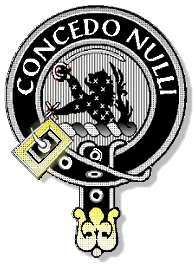
The "Old Little of Meikledale" Version of the
Little Badge
From the time of King Charles II
The Latin Inscription
Means "Never Surrender"
Courtesy of P.
J. Little
Copyright © 2001 Robert E. Sweeney and individual Contributors. All Rights Reserved. Prior written permission is required from Robert E. Sweeney and individual Contributors before this material can be printed or otherwise copied, displayed or distributed in any form. This is a FREE genealogy site sponsored through PAGenWeb and can be reached directly at ~Sullivan County Genealogy Project (http://www.rootsweb.com/~pasulliv)
Back to the Settlers Page